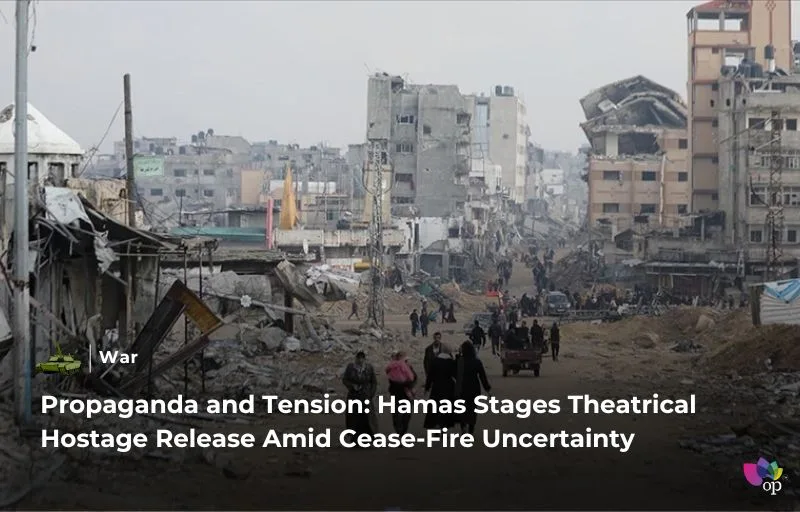Introduction
The ongoing conflict between Israel and Hamas saw another carefully orchestrated hostage exchange on Saturday (15 February), with three Israeli captives—Sagui Dekel-Chen, Yair Horn, and Alexander “Sasha” Trupanov—released in exchange for 369 Palestinian prisoners. The handover, conducted in Khan Younis, was not just a logistical process but a meticulously staged propaganda event by Hamas and Palestinian Islamic Jihad (PIJ). The setting, the symbolism, and the messaging were all designed to reinforce Hamas’s narrative and exert pressure on Israel and international mediators.
This latest exchange marks a significant moment, as it is the first time Hamas and PIJ have coordinated their hostage releases rather than conducting separate handovers. With both groups leveraging the event for political and psychological impact, the release underscores the broader strategic calculations at play in the ongoing negotiations and the fragile cease-fire agreement.
Symbolism and Psychological Warfare
Hamas transformed the hostage release into a spectacle filled with symbolic gestures and provocative imagery. The terrorists involved in the handover wore stolen Israeli military uniforms and carried captured weapons, a clear attempt to portray themselves as victors in the conflict. Additionally, the hostages were reportedly transported in a vehicle that had been taken during the October 7 attack, further reinforcing the group’s narrative of dominance.
A striking element of the event was the large banners displayed at the site, written in broken Hebrew, seemingly aimed at delivering psychological blows to the Israeli public. One of the most notable signs referenced former U.S. President Donald Trump’s past statements about relocating Gazans, stating, “No migration except to Jerusalem.” This message not only rejected the idea of displacement but also signaled Hamas’s continued defiance.
A particularly chilling piece of propaganda was an hourglass featuring images of Israeli hostage Matan Zangauker and his mother, Einav, one of the leading voices advocating for the return of captives. The hourglass, with the message “Time is running out,” was reportedly meant to be handed to Zangauker’s family, adding a psychological dimension to the event.
The Role of Khan Younis in the Staging
The release point in Khan Younis was not randomly chosen. The location was carefully selected to expose the hostages to the devastation caused by Israeli military operations in Gaza, further fueling Hamas’s narrative of victimhood and resilience. Reports indicate that the site was in close proximity to the former residence of Yahya Sinwar, Hamas’s military leader, who was killed last year. This placement was likely a deliberate move to create a symbolic connection between Sinwar’s legacy and the ongoing struggle.
Additionally, the area was adorned with flags of various Arab nations that have opposed the displacement of Palestinians, reinforcing a broader regional message. By doing so, Hamas sought to frame the event not just as a hostage release but as a demonstration of solidarity and resistance against Israeli policies.
The Prisoner Exchange: A Controversial Trade
In return for the release of the three Israeli hostages, Israel agreed to free 369 Palestinian prisoners, most of whom were detained following the October 7 attacks. Among those being released, 24 individuals are set to be deported. However, the most high-profile name on the list is Ahmed Barghouti, a longtime associate of Fatah leader Marwan Barghouti.
Ahmed Barghouti was convicted for his involvement in a series of attacks during the Second Intifada that resulted in the deaths of 12 Israelis. Having served 13 life sentences, his impending release—likely through deportation to Egypt—has sparked debate. His case highlights the significant political and security implications of the exchange, as his freedom may reignite tensions both within Israeli society and among Palestinian factions.
Cease-Fire Deal: A Fragile Balance
Hamas has made it clear that the continuation of hostage releases is contingent upon Israel’s adherence to the terms of the cease-fire agreement. A spokesperson for the group emphasized that Israel must fully implement the “humanitarian protocol” outlined in the negotiated deal, or future exchanges could be jeopardized.
The deal itself remains tenuous, with both sides expressing skepticism about each other’s commitments. While Israel is under pressure from families of the hostages to secure further releases, it must also weigh the security risks associated with freeing high-profile prisoners. Hamas, meanwhile, is using the hostages as leverage, ensuring that any deviation from the agreement by Israel could be met with renewed threats or stalled negotiations.
Conclusion: A Strategic Show of Strength
This latest hostage release was not merely a humanitarian exchange but a carefully choreographed piece of psychological warfare. Hamas and PIJ took full advantage of the event to reinforce their narrative, demoralize their adversaries, and send a clear message to regional and international actors.
For Israel, the challenge remains how to balance the urgency of bringing its hostages home with the risks associated with freeing convicted terrorists. Meanwhile, Hamas continues to manipulate the hostage situation as a tool for political gain, ensuring that any future negotiations remain on their terms.
As the cease-fire agreement remains fragile, the road ahead is uncertain. What is clear, however, is that the conflict between Israel and Hamas extends far beyond the battlefield—it is a war of narratives, psychological pressure, and strategic maneuvering, with human lives caught in the middle.
References



Comments 1